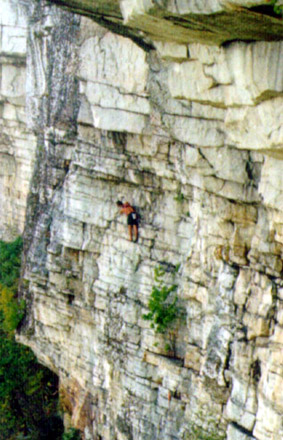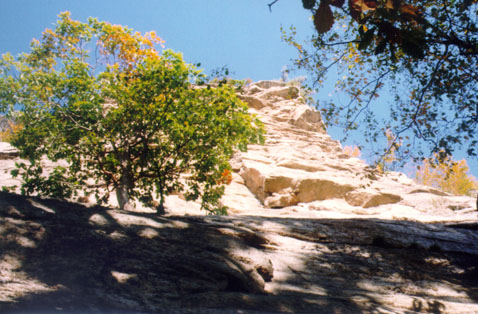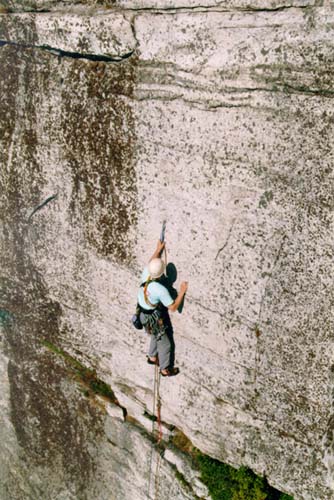Easy Verschneidung (5.2)
Easy V is a simple climb first ascended by Weissner and Kraus. The protection is good and the climbing is enjoyable. There is a neat section where you have to squeeze out of a chimney as though the rock was giving birth to you.
The rap can be a problem if you try to rap all the way to the ground from the top. Some ropes do not reach and sometimes the rope gets stuck. If you can walk over and rap down to the Three Doves rap, you may be better off.
Beginner's Delight (5.3)
Beginner's Delight offers very simple climbing, but the anchors for the belays require traditional gear rather than slinging trees. Considering most beginners that we see at the Gunks, we do not recommend this climb to someone who has not taken an anchor class with a professional guide. For those of us who are good with gear, but are learning to lead mentally, this is a very nice climb.
The climb goes up a corner for the first pitch to a comfortable ledge. The second pitch stays in the corner until you have to traverse left to the next belay which faces a face around the corner with a piton in the upper left corner. It is this third pitch that makes the climb worth while - but we do not want to spoil it for you!
This climb is located near Minty but we found this climb to be easier and more fun than Minty despite the rating. There are many options for rapping in this area and you can also walk to the Uberfall.
Gelsa (5.4)
Gelsa remains one of our favorite climbs, as one of the most popular in the area. It is easy to find Gelsa by the line of people waiting to get on the climb.
The first pitch is a very short climb up to a belay at a tree. If you try to combine the first two pitches, you get miserable rope drag. This belay station, like the other one on this climb, has room for a few people, not a few parties, so it is best to wait for the previous party to clear this belay before you start your climb.
The second pitch has a traverse that is perfect for your #4 camelot, or you can brave it out on your own. A fall would leave you hanging under a bulging overhang. The third pitch is the best (see picture). A series of stems and gymnastic moves brings you to the top of the climb.
You can finish the climb by continuing up the corner, but we opt for the overhang on the left side at the very top.
Jackie (5.5)


This remains one of our favorite climbs. It tends to have a line at the bottom no matter what time of day you come during the weekend. We once met a guy who had climbed this climb 80 times! There is a lot of room on the GT ledge (first belay) on this climb which means that there will often be several parties on it at once. Please keep this in mind when you set your anchor.
High Exposure (5.6)
This climb is an ultimate classic at the Gunks. The first pitch of the actual route is a simple 5.5, though there are many alternate routes for the first pitch, allowing the climb to be as high as 5.10. We have found that the first pitch of the 5.5 seems to be a bit longer than our rope. We stay in the notch all the way up, then step right. Some people climb the notch until there is a short face on the right then they climb that face.
The last pitch of High E is the famous pitch. The belay ledge is in a huge horizontal slice out of the rock, so that there is a roof over your head. When facing the cliff, the pitch goes up left on to a shelf, then traverses the the right. At that point, you have to lean out and reach for the rock above your head. This is the scary move.
The rest of the climb stays to the left near the edge - just follow the pitons. If you are good with body positioning and you stay to the left, this is not a strenuous climb. It is generally considered a stiff 5.6.
Shockley's Ceiling (5.6)
The ceiling of this climb is very difficult for shorter people, but is not necessarily easy of you are tall.
Just a word of friendly advice: Please do not get over confident after the roof and stop putting an adequate amount of protection in. We once had to retrieve an injured climber who fell 40 feet on this climb and landed just below the roof.
It was a great effort to get to the climber, get him to the ground, then go to the top and rappel down to clean his gear and return it to a ranger. All the climber did was grab a sandy ledge and he fell backwards.
Since he hadn't protected the region above the roof much, this turned what should have been a minor fall into an unfortunate injury.
Madame G's Sorrow (5.6)
Madam G's is one of the most popular climbs despite the semi hanging belay and the wasps later in the season. There is a new bolted rap station to the climbers right that is an airy experience. The old rap was off the tree below the station. We used to have to sit on the tree and swing under the tree (tree grows out of the side of the cliff) hanging by a leg and then let go to start the rap. Now you can just use the bolts.
The sweet thing about this climb is it mixture of face and roof. The protection is good, and the belayer can see the climber at all times during the first pitch.
For the second pitch, the rout continues to the left up a face, though there is a notch if you go to the right that is very well protected, too (the second pitch of Classic, which is another excellent climb on this wall). many people rappel after the first pitch, but we find the second pitch to be enjoyable, too.
Middle Earth (5.6)
This climb is a great climb for those who enjoy face climbs. The climb begins at a small finger crack, and continues up a sloped face. Like most Gunks climbs, Middle Earth includes a roof as well.
Sometimes we switch over to Bombs Away Dream Baby (5.8+) pitches if Middle Earth is too busy. Both climbs share the same roofs.
Moonlight (5.6)
Moonlight is a beautiful moderate climb. The first pitch follows a left facing arch / corner to a comfortable belay ledge. Once your party is on the ledge, you may wish to walk over to the tree on the right (right when facing the cliff) to belay the second pitch.
The second pitch can be divided into two pitches if rope drag is a concern. You can climb up about 30' to a tree for a belay, then continue to do the rest of the pitch as a third pitch.
The second pitch (if you do not break it into two pitches) climbs up and right and begins to traverse to an arete on the left. The footing is decent and there are small protrusions for your hands, but it is a bit scary to step around the corner. Keep an eye out for a bolt stud near the edge. This ensures that you aren't too high on the arete. The climbing here is not difficult for its grade, but it causes many climbers to hesitate. Using double ropes wisely on this climb can help protect the second. Once around the corner, the climb is not over. You must still climb up the white, smooth face to the top.



Limelight (5.7)
Limelight climbs the sloped face next to Arrow. The first pitch is decently protected and is not real scary. The second pitch has an arched flake that you must hand traverse in a layback-like position.
The protection here is decent, but the moves are still considered a bit tricky for many. The rappel for this route is over Three Doves. It is very common for someone to be climbing up the route right below this rappel. Please be considerate of the person on the climb below. Ask if it is OK for you to throw your rope or if they would like you to wait. If they wish for you to wait, please respect their wishes. There are some very hard moves right below the rappel.
Arrow (5.8)
Arrow is one of our favorite climbs at the Gunks. Two pitches of beautiful face climbing with only one hard crux move at the bolt (which Bill is clipping in the picture on the right). The route was originally cleaned on rappel and a bolt was placed at that time. The original bolt has been replaced by a more modern bolt in recent years.
When I talked to Will Crowther about his first ascent on this climb, he told me how he did a mantle for the crux move and how exciting it was to have such a tricky move. I, too, did a mantle for the crux move. We were both disappointed that tall people could grab a hold up to the left to do the crux move because the mantle is pretty impressive if you can do it without falling. Oh well!
Arrow shares the same wall as some absolutely wonderful climbs such as Limelight, Annie Oh!, Easy V, and Three Doves.
Annie Oh! (5.8)
Annie Oh! is a great face climb and a good warm-up for Three Doves. Both pitches are 5.8, and the rap is the same as Three Doves. This climb is a good alternate if Arrow is too busy, but you may find it a bit more difficult than arrow.
Watch for people rapping over this climb. They should give warning before a rope is thrown, but some visitors lack etiquette.







